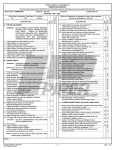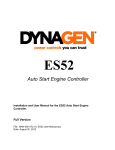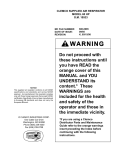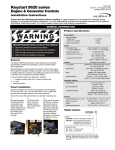Download Generac Power Systems OG 2697 User's Manual
Transcript
Generator INSTALLATION GUIDELINES Air-Cooled Generators Distributed Load Center Transfer Switch OG 2697 This booklet and the accompanying video are designed to familiarize you with the installation process for your air-cooled generator. Neither this booklet nor the accompanying video replace or supersede any information contained in any of the written documents shipped with your equipment. This booklet should only be used in conjunction with the Owner’s Manual, Installation Guide and other technical documents shipped with your equipment. Future product updates and/or modifications will be reflected in the written documentation included with your equipment. Always read all accompanying documentation carefully before attempting to install any generator, transfer switch or related equipment. It is essential to comply with all regulations established by the Occupational Safety and Health Administration (OSHA) and strict adherence to all local, state and national codes is mandatory. Study the SAFETY RULES in the Owner’s Manual carefully before installing, operating or servicing any equipment. Use this guide ONLY in conjunction with the Owner’s Manual and Installation Guide shipped with the generator. The generator can operate safely, efficiently and reliably only if it is properly installed, operated and maintained. your local dealer or other competent, qualified electrician or installation technician who is familiar with applicable codes, standards and regulations. The operator also must comply with all such codes, standards and regulations. Installation, operation, servicing and repair of this (and related) equipment must always comply with applicable codes, standards, laws and regulations. Adhere strictly to local, state and national electrical and building codes. Comply with regulations the Occupational Safety and Health Administration (OSHA) has established. Also, ensure that the generator is installed, operated and serviced in accordance with the manufacturer’s instructions and recommendations. Following installation, do nothing that might render the unit unsafe or in non-compliance with the aforementioned codes, standards, laws and regulations. The manufacturer cannot anticipate every possible circumstance that might involve a hazard. The warnings in this manual, and on tags and decals affixed to the unit are, therefore, not all-inclusive. Despite the safe design of this generator, operating this equipment imprudently, neglecting its maintenance or being careless can cause possible injury or death. Permit only responsible and capable persons to install, operate or maintain this equipment. Engine exhaust fumes contain carbon monoxide gas, which can be DEADLY. This dangerous gas, if breathed in sufficient concentrations, can cause unconsciousness or even death. For that reason, adequate ventilation must be provided. Exhaust gases must be piped safely away from any building or enclosure that houses the generator to an area where people, animals, etc., will not be harmed. Potentially lethal voltages are generated by these machines. Ensure all steps are taken to render the machine safe before attempting to work on the generator. General Hazards For safety reasons, the manufacturer recommends that this equipment be installed, serviced and repaired by This exhaust system must be installed properly, in strict compliance with applicable codes and standards. to isolate the electrical system from the utility distribution system when the generator is operating. Failure to isolate the electrical system by these means will result in damage to the generator and may also result in injury or death to utility workers due to backfeed of electric energy. Keep hands, feet, clothing, etc., away from drive belts, fans and other moving or hot parts. Never remove any drive belt or fan guard while the unit is operating. If an open bottom is used, the engine-generator is to be installed over non-combustible materials and should be located such that combustible materials are not capable of accumulating under the generator set. Adequate, unobstructed flow of cooling and ventilating air is critical to prevent buildup of explosive gases and to ensure correct generator operation. Do not alter the installation or permit even partial blockage of ventilation provisions, as this can seriously affect safe operation of the generator. Only qualified, competent installation contractors or electricians thoroughly familiar with applicable codes, standards and regulations should install this standby electric power system. The installation must comply strictly with all codes, standards and regulations pertaining to the installation. Keep the area around the generator clean and uncluttered. Remove any materials that could become hazardous. When working on this equipment, remain alert at all times. Never work on the equipment when physically or mentally fatigued. After the system has been installed, do nothing that might render the installation in non-compliance with such codes, standards and regulations. Generator Installation These generators are air-cooled, enginedriven generator sets designed to supply electric power that operates critical electrical loads during utility power failure. Your generator was factory-installed in a weather resistant, all metal enclosure and are intended for outdoor installation only. NFPA Standards The following published standards booklets pertaining to standby electrical systems are available from the National Fire Protection Association (NFPA), Batterymarch Park, Quincy, MA 02269: NFPA 37, STATIONARY COMBUSTION ENGINES AND GAS TURBINES Before Installation The generator’s rated wattage/amperage capacity must be adequate to handle all electrical loads that the unit will power. The critical (essential) loads may need to be grouped together and wired into a separate “emergency” distribution panel. NFPA 54, NATIONAL FUEL GAS CODE NFPA 58, LIQUIFIED PETROLEUM GAS CODE NFPA 70, NATIONAL ELECTRIC CODE (NEC) Connecting this generator to an electrical system, normally supplied by an electric utility, shall be by means of a transfer switch, NFPA 99, STANDARD FOR HEALTH CARE FACILITIES NFPA 101, LIFE SAFETY CODE Grounding the Generator NFPA 110, STANDARD FOR EMERGENCY AND STANDBY POWER SYSTEMS A grounding lug is provided on the generator mounting base for the purpose of grounding the frame and the external electrically conductive parts of this equipment to an approved earth ground and/or grounding rods where required by the National Electrical Code. Grounding procedures must meet local regulations. NFPA 220, STANDARD TYPES OF BUILDING CONSTRUCTION NOTE: It is essential to use the latest version of any standard to ensure that the generator and its accessories comply with all the applicable standards and local codes. Battery Installation Standby generators installed with automatic transfer switches will crank and start automatically when NORMAL (UTILITY) source voltage is removed or is below an acceptable preset level. To prevent such automatic start-up and possible injury to personnel, do not connect battery cables until certain that normal source voltage at the transfer switch is correct and the system is ready to be placed into operation. Other Published Standards In addition to NFPA standards, the following information pertaining to the installation and use of standby electric systems is available: Article X, NATIONAL BUILDING CODE, available from the American Insurance Association, 85 John Street, New York, NY 10038. Storage batteries give off explosive hydrogen gas. This gas can form an explosive mixture around the battery for several hours after charging. The slightest spark can ignite the gas and cause an explosion. Such an explosion can shatter the battery and cause blindness or other injury. Any area that houses a storage battery must be properly ventilated. Do not allow smoking, open flame, sparks or any spark producing tools or equipment near the battery. AGRICULTURAL WIRING HANDBOOK, obtainable from the Food and Energy Council, 909 University Avenue, Columbia, MO 65201. ASAE EP-364.2, INSTALLATION AND MAINTENANCE OF FARM STANDBY ELECTRIC POWER, available from the American Society of Agricultural Engineers, 2950 Niles Road, St. Joseph, MI 49085. Battery electrolyte fluid is an extremely caustic sulfuric acid solution that can cause severe burns. Do not permit fluid to contact eyes, skin, clothing, painted surfaces, etc. Wear protective goggles, protective clothing and gloves when handling a battery. If fluid is spilled, flush the affected area immediately with clear water. A52.1, AMERICAN NATIONAL STANDARDS FOR CHIMNEYS, FIREPLACES AND VENTING SYSTEMS, available from the American National Standards Institute, 1430 Broadway, New York, NY 10018. The installer must comply with all applicable state and local codes. Do not dispose of the battery in a fire. The battery is capable of exploding. Do not open or mutilate the battery. Released electrolyte can be toxic and harmful to the skin and eyes. Servicing of batteries is to be performed or supervised by personnel knowledgeable of batteries and the required precautions. Keep unauthorized personnel away from batteries. The battery represents a risk of high short-circuit current. When working on the battery, always remove watches, rings or other metal objects, and only use tools that have insulated handles. For recommended batteries, see the Installation Guide. All batteries must be at 100 percent state of charge before they are installed on the generator. When using maintenance-free batteries, it is not necessary to check the specific gravity or electrolyte level. Have these procedures performed at the intervals specified in the “Maintenance” section in the Owner’s Manual. A negative ground system is used. Battery connections are shown on the wiring diagrams. Make sure all batteries are correctly connected and terminals are tight. Observe battery polarity when connecting batteries to the generator set. Vented Batteries The electrolyte is a diluted sulfuric acid that is harmful to the skin and eyes. It is electrically conductive and corrosive. The following procedures are to be observed: Wear full eye protection and protective clothing. If electrolyte contacts the skin, wash it off immediately with water. If electrolyte contacts the eyes, flush thoroughly and immediately with water and seek medical attention. NOTE: Damage could result if the battery connections are made in reverse. Spilled electrolyte is to be washed down with an acid-neutralizing agent. A common practice is to use a solution of one pound (500 grams) bicarbonate of soda to one gallon (4 liters) of water. The bicarbonate of soda solution is to be added until the evidence of reaction (foaming) has ceased. The resulting liquid is to be flushed with water and the area dried. Lead acid batteries present a risk of fire because they generate hydrogen gas. The following procedures are to be followed: DO NOT SMOKE when near batteries. DO NOT cause flame or spark in battery area. Discharge static electricity from body before touching batteries by first touching a grounded metal surface. Before You Begin Carefully read and follow all of the procedures and safety precautions detailed in the installation guide. If you do not completely understand any portion of the installation manual, technical manual or other factory-supplied documents, contact an authorized dealer for assistance. Fully comply with all relevant NEC, NFPA and OSHA standards as well as all federal, state and local building and electric codes. As with any generator, this unit must be installed in accordance with current NFPA 37 and NFPA 70 standards as well as any other federal, state, and local codes for minimum distances from other structures. Contact the local inspector or city hall to make sure you are aware of all state and local codes and regulations that could impact installation. Secure all required permits before starting the job. Site Preparation & Generator Placement Locate the mounting pad as close as possible to the transfer switch and fuel supply. Leave adequate room around the pad for service access (check local code) and place the pad high enough to keep rising water from reaching the generator. Choose an open space that will provide adequate and unobstructed airflow. Place the unit so air vents won’t become clogged with leaves, grass, snow or debris. Make sure exhaust fumes will not enter the building through eaves, windows, ventilation fans or other air intakes. Dig a rectangular area approximately five inches deep and about six inches longer and wider than the footprint of the generator. Cover with polyurethane film and fill with pea gravel or crushed stone. Compact and level the stone. Inspect the generator for shipping damage and, if necessary, file a claim with the shipper. Remove the bolts holding the generator base frame to the wooden pallet. Make sure the lifting equipment you’ll be using has sufficient capacity to safely handle the weight of the generator. Use nylon lifting straps and connect them to the lifting eyes on each corner of the base frame to avoid damaging the enclosure. Set the generator onto the pad so that the gravel bed extends several inches beyond the generator on all sides. Make sure the generator is level within ½ inch. Some locations require the use of a poured concrete mounting pad. If you’re using a concrete pad, secure the base frame of the generator to the pad with appropriately sized masonry bolts or other fasteners specified by local code. Connect an approved ground strap to the grounding lug on the base frame and to an approved earth ground or grounding rod as specified by local regulations. Check the engine oil, and if necessary, add enough of the recommended oil to bring the level up to the FULL mark on the dipstick. Be careful not to overfill the crankcase. Converting To LP Vapor The generator was configured for natural gas operation at the factory. Switching over to LP vapor is a simple procedure. On models with the V-Twin engine, simply flip the fuel selection switch from natural gas to LP. On models with a single-cylinder engine, start by making sure the battery is disconnected. Disconnect the two wires from the solenoid and remove the fuel hose from the outlet port. Remove the steel plug from the number one outlet port and the brass fitting for the fuel hose from the number two port. Using a quality sealant on the threaded fittings, install the brass fitting in port one and the steel plug in port two. Replace the fuel hose and clamp. Then reconnect the wires to the solenoid. Finally, insert the plastic plug that came with the generator into the hole on the bottom of the air cleaner base. Installing & Connecting Gas Lines Both natural gas and LP vapor are highly volatile substances, so strict adherence to all safety procedures, codes, standards and regulations is essential. Gas line connections should be made by a certified plumber familiar with local codes. Always use AGA-approved gas pipe and a quality pipe sealant or joint compound. Most applications will require a manual shutoff valve on the fuel line. When connecting the gas line to the generator, use a short section of UL Listed or AGAapproved flexible fuel line in accordance with local regulations. The purpose of the flexible fuel line is to ensure that vibration from the generator does not cause a gas leak at one of the connection points, so it’s important that the line be installed with as few bends as possible. Never bend the flexible fuel line to avoid using an elbow. Bending the flexible line decreases its ability to absorb vibrations and defeats its purpose. Check the gas pressure at the secondary regulator to make sure there’s enough pressure for proper generator operation. The local gas supplier is responsible for ensuring adequate pressure, so if the pressure is too low, or if it’s greater than 14 inches of water column, contact the gas supplier. When you’ve finished checking the gas pressure, close the manual shutoff valve. External Electrical Connections Drill a 1¾ inch hole and feed the conduit through the hole. Remove the knockout in the back of the connection box, feed the wires through the back of the box and secure the conduit with the lock nut. Seal the hole with silicone caulk. Don’t forget to caulk the hole inside the house as well. Mount the connection box so that it completely covers the hole in the wall. Connect all wires to the lugs in the connection box (black to black, red to red and white to white). Attach the green ground wire to the ground screw and connect the two ends of the four-pin plug connector. Replace the protective cover plate … … and lock the connection box. 10 Installing The Automatic Transfer Switch Before beginning any installation, make sure power is shut OFF to the main distribution panel and carefully read the Installation Guide that came with your transfer switch. The distributed load center switch must be mounted close enough to the main distribution panel to accommodate the two-foot, pre-wired conduit. Make sure no water or corrosive substances can drip onto the transfer switch enclosure. Always inspect the switch for shipping damage. Never mount a transfer switch that shows any evidence of damage. Protect against impact and mount the switch vertically to a rigid support structure. Make sure the switch is level and plumb. Your transfer switch is an open transition switch. Open transition switches prevent electrical feedback between the generator and the utility by only allowing load circuits to be connected to one power supply at a time. Each wire in the pre-wired transfer switch is color-coded so you can easily match circuits in the main panel to their new breakers in the transfer switch. 11 When three-conductor wiring is used, two 120 volt circuits will often share the same neutral wire. To avoid overloading the neutral, you should either move BOTH of the circuits that share the neutral or don’t move either of them. When moving two circuits with a shared neutral, they should be connected to adjacent positions (one above the other) in the transfer switch. That will assure that the two hot wires are on separate phases and will maintain their relationship to neutral. Select a circuit you want to back up and remove the power lead from the breaker. Using UL Listed wire nuts, reconnect the power lead to a matching breaker in the transfer switch. Make sure each circuit you move is protected by the same size breaker in the transfer switch. 15 Amp circuits must be connected to 15 Amp breakers and 20 Amp circuits to 20 Amp breakers. For every circuit you move to the transfer switch, connect the white neutral wire to the neutral bar in the distribution panel. 12 Install a 2-pole breaker in the distribution panel to protect the transfer switch. The required Amp rating of the breaker depends on which transfer switch you’re using, so refer to the Installation Guide before purchasing the breaker. Install the breaker in two adjacent empty slots (one above the other) in the main panel. When all emergency circuits have been moved to the transfer switch, close the main breaker to restore utility power and make sure utility voltage at the transfer switch is correct. Refer to NFPA 70E for the safety equipment required when working inside a live transfer switch. Before purchasing a battery for the generator, refer to the Installation Guide for a list of recommended batteries. Follow all of the procedures and safety precautions in the Installation Guide when installing the battery. Operational Tests Switch the generator’s main circuit breaker OFF and put the mode switch in the OFF position. Make sure utility power is OFF and place all of the emergency circuit breakers, in the transfer switch, in the OFF position. 13 Locate the transfer handle and insert the metal end into the slot in the main contactor assembly. Pull the handle DOWN to move the main contacts to the standby power (generator) position. NEVER OPERATE THE TRANSFER SWITCH MANUALLY WHEN LOADS ARE CONNECTED. Put the generator’s mode switch in MANUAL to start the engine. Allow the engine to warm up, then switch the generator’s main breaker to the ON position. The generator is now supplying electricity to the transfer switch but is not carrying any load. Check to be sure that voltage and frequency from the generator is correct. If line-to-line voltage is not 240 volts, refer to the Installation Guide for the proper adjustment procedures. If line-to-neutral voltage is not 120 volts, check the neutral connection between the generator and transfer switch. When finished checking the voltage, switch the generator’s main circuit breaker OFF and put the mode switch in the OFF position to shut down the generator. Make sure the 2-pole circuit breaker you installed in the main distribution panel is in the OFF position. 14 Use the transfer handle to move the main contacts in the transfer switch to the UP (utility) position. Switch the 2-pole breaker ON in the distribution panel. Now switch the generator’s main breaker ON and put the mode switch in AUTO. Shut OFF utility power and make sure the generator starts automatically. If everything worked properly, switch the main breaker to ON and make sure that power is automatically transferred back to the utility. 15 After the engine has completed its cool down cycle and shut down, shut OFF utility power again. When the generator is supplying power to the transfer switch, move the breakers in the switch to the ON position one at a time until the generator has accepted the entire emergency load. With the generator carrying the entire emergency load, re-check gas pressure to verify that it is at the same level it was before you started the generator. Switch the main breaker ON to restore utility power. The generator will continue running to allow the engine to cool down before shutting itself OFF. Unhook the gas meter and reinstall the port plug on the regulator. 16 Shut OFF utility power again. The generator should start and the entire emergency load should transfer to the generator. Close the main breaker to restore utility power and allow the engine to cool down and shut itself OFF. Setting The Automatic Exercise Function With the mode switch in AUTO, press the EXERCISER switch. Hold it down for at least 10 seconds and release. The generator should start within a few seconds. The unit will run for about 12 minutes before shutting itself down automatically. Once set, the generator will exercise each week at the same time. Be sure to show the owner how to set the exercise function on the day and time he/she wants the unit to exercise. If the battery is ever disconnected for any reason, the exercise function will have to be reset. If your generator is equipped with the low speed exercise feature, it was enabled at the factory and no adjustment is needed. As you can see, this installation is not difficult. Simply follow all of the instructions that come with the generator and observe all safety procedures, applicable codes and regulations. 17 Notes 18 Every installation has its own unique set of circumstances and requirements. This booklet provides guidelines for basic installations only and is not intended to cover all applications. If you have any questions or concerns after carefully reading all documentation received with the equipment, contact your local dealer for assistance. Part# 0G2697 Printed in USA 08/06 ©2006 Generac Power Systems, Inc. All rights reserved.






























